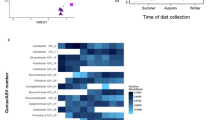Abstract
Previous studies have shown that exposure to urea-supplemented food inhibited fecundity inDrosophila females, and that this inhibition was not expressed when females were given a choice between regular and urea-supplemented food as an oviposition substrate. We assayed fecundity, on both regular food and urea-supplemented food, at 5, 15 and 25 days post eclosion on females from ten laboratory populations ofDrosophila melanogaster. The females assayed came from one of two treatments; they were maintained as adults on either regular or urea-supplemented food. We found that exposure to urea-supplemented food inhibited fecundity, relative to the levels exhibited on regular food, regardless of whether the urea was present in the assay medium, or in the medium on which the flies were maintained over the course of the experiment, thereby suggesting that urea has both a long-term (possibly physiological) as well as a short-term (possibly behavioural) inhibitory effect on fecundity ofDrosophila females. We also tested and ruled out the hypothesis that prior yeasting could ameliorate the inhibitory effect of urea in the assay medium on fecundity, as this was a possible explanation of why flies given a choice between regular and urea-supplemented food did not exhibit a preference for regular food in a previous study.
Similar content being viewed by others
References
Aiken R B and Gibo D L 1979 Changes in fecundity ofDrosophila melanogaster andD. simulans in response to selection for competitive ability;Oecologia 43 63–77
Botella L M, Moya A, Gonzales A C and Mensua J L 1985 Larval stop, delayed development and survival in overcrowded cultures ofDrosophila melanogaster: effect of urea and uric acid;J. Insect Physiol. 31 179–185
Borash D J, Gibbs A G, Joshi A and L D Mueller 1998 A genetic polymorphism maintained by natural selection in a temporally varying environment;Am. Nat. 151 148–156
Budnik M and Brncic D 1976 Effects of larval biotic residues on viability in four species ofDrosophila;Evolution 29 777–781
Chiang H C and Hodson A C 1950 An analytical study of population growth inDrosophila melanogaster, Ecol. Monogr. 20 173–206
Del Solar E and Palomino H 1966 Choice of oviposition inDrosophila melanogaster;Am. Nat. 100 127–133
Joshi A1997 Laboratory studies of density-dependent selection: adaptations to crowding inDrosophila melanogaster;Curr. Sci. 72 555–561
Joshi A, Knight C D and Mueller L D 1996a Genetics of larval urea tolerance inDrosophila melanogaster, Heredity 77 33–39
Joshi A, Shiotsugu J and Mueller L D 1996b Phenotypic enhancement of longevity by environmental urea inDrosophila melanogaster;Exp. Gerontol. 31 533–544
Joshi A, Oshiro W A, Shiotsugu J and Mueller L D 1997 Within- and among-population variation in oviposition preference for urea-supplemented food inDrosophila melanogaster;J. Biosci. 22 325–338
Mueller L D 1988 Density-dependent population growth and natural selection in food-limited environments: theDrosophila model;Am. Nat. 132 786–809
Mueller L D 1995 Adaptation and density-dependent natural selection; inGenetics of natural populations: the continuing importance’ of Tlzeodosius Dobzizansky (ed.) L Levine (New York: Columbia University Press) pp 101–124
Mueller L D, Gonzalez-Candelas F and Sweet V F 1991 Components of density-dependent population dynamics: models and tests withDrosophila;Am. Nat. 137 457–475
Rose M R, Nusbaum T J and Chippindale A K 1996 Laboratory evolution: the experimental wonderland and the Cheshire Cat syndrome; inAdaptation (eds) M R Rose and G V Lauder (San Diego: Academic Press) pp 221–241
Sheeba V, Madhyastha N A A and Joshi A 1998 Oviposition preference for novel versus normal food resources in laboratory populations ofDrosophila melanogaster;J. Biosci. 23 93–100
Shiotsugu J, Leroi A M, Yashiro H, Rose M R and Mueller L D 1997 The symmetry of correlated responses in adaptive evolution: an experimental study usingDrosophila;Evolution 51 163–172
Author information
Authors and Affiliations
Corresponding author
Rights and permissions
About this article
Cite this article
Joshi, A., Oshiro, W.A., Shiotsugu, J. et al. Short- and long-term effects of environmental urea on fecundity inDrosophila melanogaster . J. Biosci. 23, 279–283 (1998). https://doi.org/10.1007/BF02720030
Received:
Accepted:
Published:
Issue Date:
DOI: https://doi.org/10.1007/BF02720030




